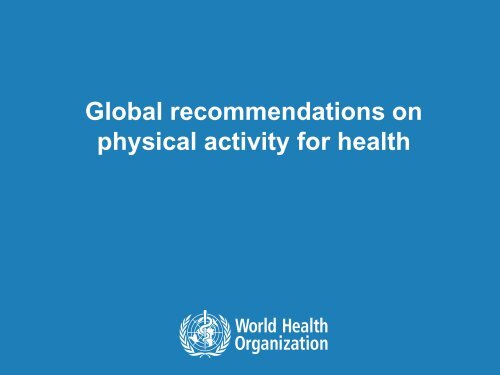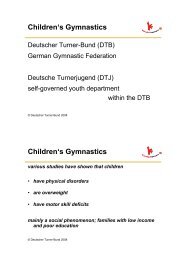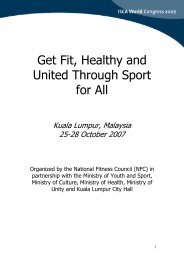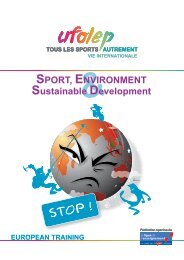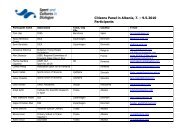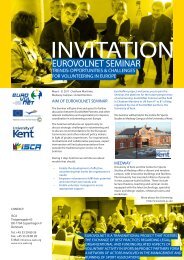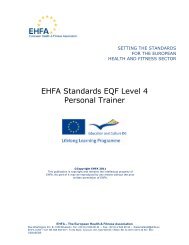Global recommendations on physical activity for health - ISCA
Global recommendations on physical activity for health - ISCA
Global recommendations on physical activity for health - ISCA
You also want an ePaper? Increase the reach of your titles
YUMPU automatically turns print PDFs into web optimized ePapers that Google loves.
<str<strong>on</strong>g>Global</str<strong>on</strong>g> <str<strong>on</strong>g>recommendati<strong>on</strong>s</str<strong>on</strong>g> <strong>on</strong><br />
<strong>physical</strong> <strong>activity</strong> <strong>for</strong> <strong>health</strong>
Source: WHO's report <strong>on</strong> "<str<strong>on</strong>g>Global</str<strong>on</strong>g> <strong>health</strong> risks"<br />
Physical in<strong>activity</strong> 4 th leading risk factor in global mortality<br />
<str<strong>on</strong>g>Global</str<strong>on</strong>g> <str<strong>on</strong>g>recommendati<strong>on</strong>s</str<strong>on</strong>g><br />
60%<br />
<strong>on</strong> <strong>physical</strong><br />
of<br />
<strong>activity</strong><br />
global<br />
<strong>for</strong> <strong>health</strong> | July 2010<br />
deaths due to NCDs
What has WHO been doing to mobilize a global resp<strong>on</strong>se?<br />
2000<br />
<str<strong>on</strong>g>Global</str<strong>on</strong>g> Strategy <strong>for</strong> the Preventi<strong>on</strong><br />
and C<strong>on</strong>trol of N<strong>on</strong>-communicable<br />
Diseases<br />
2002<br />
2003<br />
2004<br />
2008<br />
A six-year <str<strong>on</strong>g>Global</str<strong>on</strong>g> Acti<strong>on</strong> Plan to address cardiovascular disease, cancer,<br />
respiratory disease and diabetes was endorsed by the WHO World Health<br />
Assembly <strong>on</strong> 24 May 2008.<br />
<str<strong>on</strong>g>Global</str<strong>on</strong>g> <str<strong>on</strong>g>recommendati<strong>on</strong>s</str<strong>on</strong>g> <strong>on</strong> <strong>physical</strong> <strong>activity</strong> <strong>for</strong> <strong>health</strong> | July 2010
What has WHO been doing to mobilize a global resp<strong>on</strong>se?<br />
<str<strong>on</strong>g>Global</str<strong>on</strong>g> Acti<strong>on</strong> Plan N<strong>on</strong>communicable diseases 2008-2013 (WHA 2008)<br />
Six objectives:<br />
1. Raising the priority accorded to NCD in development<br />
work at global and nati<strong>on</strong>al levels<br />
2. Establishing and strengthening nati<strong>on</strong>al policies and<br />
programmes<br />
3. Reducing and preventing risk factors<br />
4. Prioritizing research <strong>on</strong> preventi<strong>on</strong> and <strong>health</strong> care<br />
5. Strengthening partnerships<br />
6. M<strong>on</strong>itoring NCD trends and assessing progress made<br />
at country level<br />
Under each objective acti<strong>on</strong>s <strong>for</strong> member states, WHO Secretariat and<br />
internati<strong>on</strong>al partners<br />
<str<strong>on</strong>g>Global</str<strong>on</strong>g> <str<strong>on</strong>g>recommendati<strong>on</strong>s</str<strong>on</strong>g> <strong>on</strong> <strong>physical</strong> <strong>activity</strong> <strong>for</strong> <strong>health</strong> | July 2010
NCD Acti<strong>on</strong> Plan 2008 Objective 3<br />
Physical Activity: acti<strong>on</strong>s <strong>for</strong> Member States<br />
Ensure that <strong>physical</strong> envir<strong>on</strong>ments support safe active<br />
commuting, and create space <strong>for</strong> recreati<strong>on</strong>al <strong>activity</strong>, by:<br />
• Ensuring that walking, cycling and other <strong>for</strong>ms of<br />
<strong>physical</strong> <strong>activity</strong> are accessible to and safe <strong>for</strong> all;<br />
• Improving sports, recreati<strong>on</strong> and leisure facilities;<br />
• Increasing the number of safe spaces available <strong>for</strong><br />
active play.<br />
<str<strong>on</strong>g>Global</str<strong>on</strong>g> <str<strong>on</strong>g>recommendati<strong>on</strong>s</str<strong>on</strong>g> <strong>on</strong> <strong>physical</strong> <strong>activity</strong> <strong>for</strong> <strong>health</strong> | July 2010
<str<strong>on</strong>g>Global</str<strong>on</strong>g> Activities<br />
http://www.who.int/diet<strong>physical</strong><strong>activity</strong>/en/<br />
<str<strong>on</strong>g>Global</str<strong>on</strong>g> <str<strong>on</strong>g>recommendati<strong>on</strong>s</str<strong>on</strong>g> <strong>on</strong> <strong>physical</strong> <strong>activity</strong> <strong>for</strong> <strong>health</strong> | July 2010
<str<strong>on</strong>g>Global</str<strong>on</strong>g> <str<strong>on</strong>g>recommendati<strong>on</strong>s</str<strong>on</strong>g> <strong>on</strong><br />
<strong>physical</strong> <strong>activity</strong> <strong>for</strong> <strong>health</strong><br />
• Why?<br />
– Evidence based starting point to promote <strong>physical</strong> <strong>activity</strong> + advocacy<br />
– Limited existence of nati<strong>on</strong>al guidelines in low and middle income<br />
countries; different guidelines<br />
• PA independent risk factor <strong>for</strong>:<br />
1. Cardio-respiratory <strong>health</strong> (cor<strong>on</strong>ary heart disease, cardiovascular disease,<br />
stroke and hypertensi<strong>on</strong>)<br />
2. Metabolic Health (diabetes and obesity)<br />
3. Musculo-skeletal <strong>health</strong> (b<strong>on</strong>e <strong>health</strong>, osteoporosis)<br />
4. Cancer (breast and col<strong>on</strong> cancer)<br />
5. Functi<strong>on</strong>al Health and preventi<strong>on</strong> of falls<br />
6. Anxiety, depressi<strong>on</strong>, cognitive functi<strong>on</strong>s<br />
<str<strong>on</strong>g>Global</str<strong>on</strong>g> <str<strong>on</strong>g>recommendati<strong>on</strong>s</str<strong>on</strong>g> <strong>on</strong> <strong>physical</strong> <strong>activity</strong> <strong>for</strong> <strong>health</strong> | July 2010
<str<strong>on</strong>g>Global</str<strong>on</strong>g> Physical Activity Recommendati<strong>on</strong>s<br />
Intensity of <strong>activity</strong><br />
Domains of <strong>activity</strong><br />
recreati<strong>on</strong><br />
and sports<br />
moderate<br />
transportati<strong>on</strong><br />
vigorous<br />
household<br />
Type of <strong>activity</strong><br />
work/school<br />
Aerobic Strength Balance Flexibility<br />
<str<strong>on</strong>g>Global</str<strong>on</strong>g> <str<strong>on</strong>g>recommendati<strong>on</strong>s</str<strong>on</strong>g> <strong>on</strong> <strong>physical</strong> <strong>activity</strong> <strong>for</strong> <strong>health</strong> | July 2010
<str<strong>on</strong>g>Global</str<strong>on</strong>g> <str<strong>on</strong>g>recommendati<strong>on</strong>s</str<strong>on</strong>g> <strong>on</strong><br />
<strong>physical</strong> <strong>activity</strong> <strong>for</strong> <strong>health</strong><br />
• Target audience: nati<strong>on</strong>al policy makers<br />
• What are these?<br />
Populati<strong>on</strong> based <strong>physical</strong> <strong>activity</strong> <strong>for</strong> 3 age groups<br />
(5-17 yrs; 18-64 yrs and 65 yrs and older):<br />
• what type (aerobic, strength, flexibility, balance)?<br />
• how often?<br />
• <strong>for</strong> how l<strong>on</strong>g?<br />
• how intense (how hard a pers<strong>on</strong> works to do the<br />
<strong>activity</strong>)?<br />
• how much in total?<br />
<str<strong>on</strong>g>Global</str<strong>on</strong>g> <str<strong>on</strong>g>recommendati<strong>on</strong>s</str<strong>on</strong>g> <strong>on</strong> <strong>physical</strong> <strong>activity</strong> <strong>for</strong> <strong>health</strong> | July 2010
Children and youth - aged 5-17 - should:<br />
• Accumulate at least 60 minutes of moderate to vigorous<br />
intensity <strong>physical</strong> <strong>activity</strong> daily.<br />
• Amounts of <strong>physical</strong> <strong>activity</strong> greater than 60 minutes provide<br />
additi<strong>on</strong>al <strong>health</strong> benefits.<br />
• Most of the daily <strong>physical</strong> <strong>activity</strong> should be aerobic. Vigorous<br />
intensity activities should be incorporated, including those that<br />
strengthen muscle and b<strong>on</strong>e at least 3 times per week.<br />
<str<strong>on</strong>g>Global</str<strong>on</strong>g> <str<strong>on</strong>g>recommendati<strong>on</strong>s</str<strong>on</strong>g> <strong>on</strong> <strong>physical</strong> <strong>activity</strong> <strong>for</strong> <strong>health</strong> | July 2010
PA includes play, games, sports,<br />
transportati<strong>on</strong>, recreati<strong>on</strong>, <strong>physical</strong><br />
educati<strong>on</strong>, or planned exercise, in the<br />
c<strong>on</strong>text of family, school, and community<br />
activities.<br />
<str<strong>on</strong>g>Global</str<strong>on</strong>g> <str<strong>on</strong>g>recommendati<strong>on</strong>s</str<strong>on</strong>g> <strong>on</strong> <strong>physical</strong> <strong>activity</strong> <strong>for</strong> <strong>health</strong> | July 2010
Adults - aged 18-64 – should:<br />
• Do at least 150 minutes of moderate-intensity aerobic <strong>physical</strong><br />
<strong>activity</strong> spread throughout the week or do at least 75 minutes of<br />
vigorous-intensity aerobic <strong>physical</strong> <strong>activity</strong> spread throughout the<br />
week or an equivalent combinati<strong>on</strong> of moderate-and vigorousintensity<br />
<strong>activity</strong>.<br />
• Aerobic <strong>activity</strong> should be per<strong>for</strong>med in bouts of at least 10<br />
minutes.<br />
• For additi<strong>on</strong>al <strong>health</strong> benefits, adults should increase their<br />
moderate-intensity aerobic <strong>physical</strong> <strong>activity</strong> to 300 minutes per<br />
week, or engage in 150 minutes of vigorous-intensity aerobic<br />
<strong>physical</strong> <strong>activity</strong> per week, or an equivalent combinati<strong>on</strong> of<br />
moderate-and vigorous-intensity <strong>activity</strong>.<br />
• Muscle-strengthening activities should be d<strong>on</strong>e involving major<br />
muscle groups <strong>on</strong> 2 or more days a week.<br />
<str<strong>on</strong>g>Global</str<strong>on</strong>g> <str<strong>on</strong>g>recommendati<strong>on</strong>s</str<strong>on</strong>g> <strong>on</strong> <strong>physical</strong> <strong>activity</strong> <strong>for</strong> <strong>health</strong> | July 2010
Older adults - 65 years old & above should:<br />
(Main <str<strong>on</strong>g>recommendati<strong>on</strong>s</str<strong>on</strong>g> are the same <strong>for</strong> adults ad older adults)<br />
• Do at least 150 minutes of moderate-intensity aerobic PA spread<br />
throughout the week or do at least 75 minutes of vigorousintensity<br />
aerobic PA spread throughout the week or an equivalent<br />
combinati<strong>on</strong> of moderate-and vigorous-intensity <strong>activity</strong>.<br />
• Aerobic <strong>activity</strong> should be per<strong>for</strong>med in bouts of at least 10<br />
minutes.<br />
• For additi<strong>on</strong>al <strong>health</strong> benefits, older adults should increase their<br />
moderate-intensity aerobic PA to 300 minutes per week, or<br />
engage in 150 minutes of vigorous-intensity aerobic PA per week,<br />
or an equivalent combinati<strong>on</strong> of moderate-and vigorous-intensity<br />
<strong>activity</strong>.<br />
<str<strong>on</strong>g>Global</str<strong>on</strong>g> <str<strong>on</strong>g>recommendati<strong>on</strong>s</str<strong>on</strong>g> <strong>on</strong> <strong>physical</strong> <strong>activity</strong> <strong>for</strong> <strong>health</strong> | July 2010
Older adults - 65 years old & above :<br />
(Specific <str<strong>on</strong>g>recommendati<strong>on</strong>s</str<strong>on</strong>g> <strong>for</strong> older adults:)<br />
• Older adults, with poor mobility, should per<strong>for</strong>m PA to enhance<br />
balance and prevent falls <strong>on</strong> 3 or more days/ week.<br />
• Muscle-strengthening activities should be d<strong>on</strong>e involving major<br />
muscle groups <strong>on</strong> 2 or more days a week.<br />
• When older adults cannot do the recommended amounts of PA due<br />
to <strong>health</strong> c<strong>on</strong>diti<strong>on</strong>s, they should be as <strong>physical</strong>ly active as their<br />
abilities and c<strong>on</strong>diti<strong>on</strong>s allow.<br />
<str<strong>on</strong>g>Global</str<strong>on</strong>g> <str<strong>on</strong>g>recommendati<strong>on</strong>s</str<strong>on</strong>g> <strong>on</strong> <strong>physical</strong> <strong>activity</strong> <strong>for</strong> <strong>health</strong> | July 2010
In adults and older adults, PA<br />
includes recreati<strong>on</strong>al (leisure) time<br />
<strong>physical</strong> <strong>activity</strong>, transportati<strong>on</strong><br />
(walking or cycling), occupati<strong>on</strong>al<br />
(work), house chores, play, games,<br />
sports or planned exercise, in the<br />
c<strong>on</strong>text of daily, family, and<br />
community activities.<br />
<str<strong>on</strong>g>Global</str<strong>on</strong>g> <str<strong>on</strong>g>recommendati<strong>on</strong>s</str<strong>on</strong>g> <strong>on</strong> <strong>physical</strong> <strong>activity</strong> <strong>for</strong> <strong>health</strong> | July 2010
<str<strong>on</strong>g>Global</str<strong>on</strong>g> <str<strong>on</strong>g>recommendati<strong>on</strong>s</str<strong>on</strong>g> <strong>on</strong><br />
<strong>physical</strong> <strong>activity</strong> <strong>for</strong> <strong>health</strong>:<br />
• Are an evidence based starting point <strong>for</strong> nati<strong>on</strong>al policy makers<br />
looking to promote <strong>physical</strong> <strong>activity</strong><br />
• Can be used by all relevant stakeholders to communicate valid and<br />
c<strong>on</strong>sistent messages <strong>on</strong> the frequency, durati<strong>on</strong>, intensity, type and<br />
total amount of <strong>physical</strong> <strong>activity</strong> <strong>for</strong> <strong>health</strong>;<br />
• Tool <strong>for</strong> <strong>health</strong> professi<strong>on</strong>als to in<strong>for</strong>m patients;<br />
• Have the potential to become a tool to link communicati<strong>on</strong> between<br />
scientists, <strong>health</strong> professi<strong>on</strong>als, journalists, interest groups and the<br />
general public;<br />
• Can be used as benchmarks <strong>for</strong> public <strong>health</strong> m<strong>on</strong>itoring and<br />
surveillance purposes.<br />
• Can support the development of <strong>physical</strong> <strong>activity</strong> policy;<br />
<str<strong>on</strong>g>Global</str<strong>on</strong>g> <str<strong>on</strong>g>recommendati<strong>on</strong>s</str<strong>on</strong>g> <strong>on</strong> <strong>physical</strong> <strong>activity</strong> <strong>for</strong> <strong>health</strong> | July 2010
Important elements of successful policies<br />
• High level political commitment<br />
• Surveillance, m<strong>on</strong>itoring and evaluati<strong>on</strong><br />
• Multi-stakeholder support<br />
• Leadership and work<strong>for</strong>ce development<br />
• Integrati<strong>on</strong> into nati<strong>on</strong>al strategies & policies<br />
• Multiple interventi<strong>on</strong> strategies<br />
• Stepwise approach to implementati<strong>on</strong><br />
• Culturally appropriate<br />
• Implementati<strong>on</strong> at different levels within "local reality"<br />
• Disseminati<strong>on</strong><br />
• Nati<strong>on</strong>al Physical Activity Guidelines<br />
<str<strong>on</strong>g>Global</str<strong>on</strong>g> <str<strong>on</strong>g>recommendati<strong>on</strong>s</str<strong>on</strong>g> <strong>on</strong> <strong>physical</strong> <strong>activity</strong> <strong>for</strong> <strong>health</strong> | July 2010
Supportive policies in promoting PA<br />
Possible <strong>physical</strong> <strong>activity</strong> promoting interventi<strong>on</strong>s include:<br />
• ensuring that walking, cycling and other <strong>for</strong>ms of <strong>physical</strong> <strong>activity</strong> are<br />
accessible and safe;<br />
• providing local play facilities <strong>for</strong> children (e.g. building walking trails);<br />
• facilitating transport to work (e.g. cycling and walking) and other<br />
<strong>physical</strong> <strong>activity</strong> strategies <strong>for</strong> the working populati<strong>on</strong>;<br />
• ensuring that school policies support the provisi<strong>on</strong> of opportunities and<br />
programmes <strong>for</strong> <strong>physical</strong> <strong>activity</strong>;<br />
• providing schools with safe and appropriate spaces and facilities so<br />
that students can spend their time actively;<br />
• providing advice or counsel in primary care; and<br />
• creating social networks that encourage <strong>physical</strong> <strong>activity</strong>.<br />
<str<strong>on</strong>g>Global</str<strong>on</strong>g> <str<strong>on</strong>g>recommendati<strong>on</strong>s</str<strong>on</strong>g> <strong>on</strong> <strong>physical</strong> <strong>activity</strong> <strong>for</strong> <strong>health</strong> | July 2010
Strategies <strong>for</strong> communicating the global<br />
<str<strong>on</strong>g>recommendati<strong>on</strong>s</str<strong>on</strong>g> at nati<strong>on</strong>al level<br />
• Adopt the global recommended levels of PA and integrate them to<br />
nati<strong>on</strong>al policies.<br />
• Nati<strong>on</strong>ally adapted messages need to be developed and widely<br />
disseminated to all relevant stakeholders, professi<strong>on</strong>al groups and to<br />
the general community.<br />
• When taking into c<strong>on</strong>siderati<strong>on</strong> nati<strong>on</strong>al/subnati<strong>on</strong>al cultural &<br />
envir<strong>on</strong>mental factors, it is advisable to develop a comprehensive,<br />
communicati<strong>on</strong> strategy <strong>for</strong> effective disseminati<strong>on</strong>.<br />
• Adopt a communicati<strong>on</strong> strategy that includes simple, understandable<br />
& adaptable messages which are culturally sensitive.<br />
<str<strong>on</strong>g>Global</str<strong>on</strong>g> <str<strong>on</strong>g>recommendati<strong>on</strong>s</str<strong>on</strong>g> <strong>on</strong> <strong>physical</strong> <strong>activity</strong> <strong>for</strong> <strong>health</strong> | July 2010
Adopt and adapt<br />
• Adaptati<strong>on</strong> and translati<strong>on</strong> of the global PA <str<strong>on</strong>g>recommendati<strong>on</strong>s</str<strong>on</strong>g><br />
must take into c<strong>on</strong>siderati<strong>on</strong>:<br />
– Cultural background, ethnic minorities, gender issues.<br />
– Social norms, religious values.<br />
– Security situati<strong>on</strong> at the nati<strong>on</strong>al and/or local levels.<br />
– Availability of safe spaces <strong>for</strong> the practice of <strong>physical</strong> <strong>activity</strong>.<br />
– Access and attendance to schools and worksite, especially related to<br />
girls and women.<br />
– Existing transport infrastructures, sports and recreati<strong>on</strong> facilities and<br />
urban design.<br />
– Patterns of participati<strong>on</strong> in all domains of <strong>physical</strong> <strong>activity</strong> (leisure,<br />
transportati<strong>on</strong> and occupati<strong>on</strong>al).<br />
– Geographical settings, seas<strong>on</strong>s and climate.<br />
– Involvement of all c<strong>on</strong>cerned sectors and actors.<br />
– Role of municipalities and local leadership.<br />
<str<strong>on</strong>g>Global</str<strong>on</strong>g> <str<strong>on</strong>g>recommendati<strong>on</strong>s</str<strong>on</strong>g> <strong>on</strong> <strong>physical</strong> <strong>activity</strong> <strong>for</strong> <strong>health</strong> | July 2010
More in<strong>for</strong>mati<strong>on</strong><br />
• Physical <strong>activity</strong>: http://www.who.int/diet<strong>physical</strong><strong>activity</strong>/pa<br />
• Pacific PA guidelines <strong>for</strong> Adults:<br />
http://www.wpro.who.int/NR/rd<strong>on</strong>lyres/6BF5EE82-8509-4B2F-8388-<br />
2CE9DBCCA0F8/0/PAG_layout2_22122008.pdf<br />
• Framework to m<strong>on</strong>itor and evaluate diet and <strong>physical</strong> <strong>activity</strong><br />
policies: http://www.who.int/diet<strong>physical</strong><strong>activity</strong>/DPASindicators<br />
• <str<strong>on</strong>g>Global</str<strong>on</strong>g> Physical Activity Questi<strong>on</strong>naire:<br />
http://www.who.int/chp/steps/GPAQ<br />
• WHO <str<strong>on</strong>g>Global</str<strong>on</strong>g> Infobase:<br />
http://infobase.who.int.<br />
<str<strong>on</strong>g>Global</str<strong>on</strong>g> <str<strong>on</strong>g>recommendati<strong>on</strong>s</str<strong>on</strong>g> <strong>on</strong> <strong>physical</strong> <strong>activity</strong> <strong>for</strong> <strong>health</strong> | July 2010


